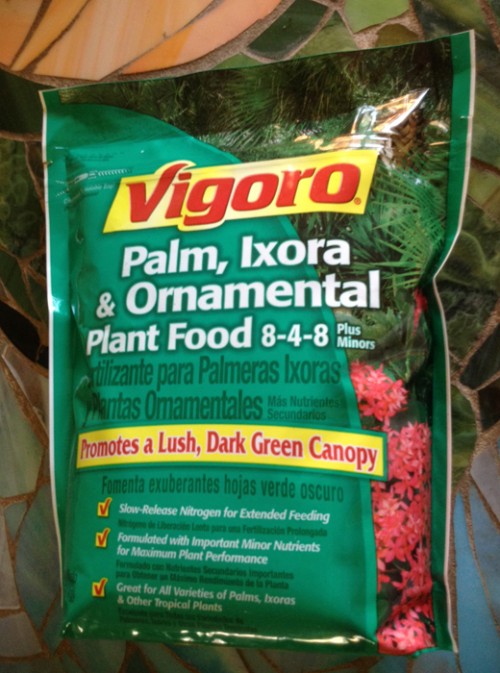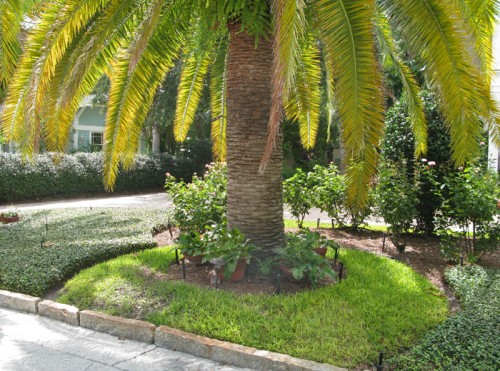It’s easy to tend to your palm tree’s unique nutritional needs. Just remember the number 3!
3 elements your palms need to stay healthy
Applied in correct combination; magnesium, iron, and manganese will keep fronds from yellowing or curling. How much and when depends on where you live. For instance, high-rainfall areas with sandy soil often need more fertilizer and microelements as these items are quickly leached from the soil.
Where to buy palm fertilizer
You most likely will find big box stores don’t have knowledge staff to answer in-depth questions, so try try buying specialty fertilizer from a local independent nursery. Nursery staff can help you customize your palm tree’s care needs and consult on health problems.
Pick a fertilizer with an approximate 3:1:3 NPK ratio.
Fertilize every 3 months
Palm trees nutritional deficiencies are easily prevented by following a yearly fertilization program. To keep your palm healthy and green, fertilize early in the season and then every 3 months for a total of 3 applications. In Tampa Bay, start at the end of March and commence at the end of October. Newly planted palms should not be fertilized until after they put out a new spear, about 2 months after planting. Pick a fertilizer with a NPK 3:1:3 ratio. There are those threes popping up again!
Cheap fertilizer can wash away after 3 rains
It’s more economical (and better for the environment) to use fertilizer that has a continuous release formula that feeds your palm tree for few months rather than using a ‘cheap’ fertilizer that will wash away after 3 rains. Improper fertilization can lead to burn, which is most evident in the new spears, turning them brown and crispy. Fertilizing along with proper watering and soil quality play large roles in the health of a palm tree. Improper fertilization practices can lead to nutrient deficiencies. Lack of fertilizing can lead to severe deficiencies and in the most extreme cases can lead to a palm’s demise.
3 steps to establishing a new palm:
- Water plays huge role in establishing a new palm. Water every day for 45 days until the risk of transplant shock has passed.
- Apply the fertilizer away from the base of the palm, staying around 18″ away from the base. Banding fertilizer around the base of the palm tree is considered a poor practice because it can damage the roots.
- Wait about 4 to 6 weeks after planting to fertilize.
[portfolio_slideshow id=4400]
Fertilizing palms DO list:
- Thoroughly read the directions on the fertilizer bag.
- Water BEFORE AND AFTER fertilizing, especially when using a quick release material. Under-fertilize rather than over-fertilize.
- Under-fertilized plants just don’t grow as fast; over-fertilize them and they may die. Pick a fertilizer with an approximate 3:1:3 NPK ratio.
- An ideal palm fertilizer has the right mix of microelements, magnesium and calcium.
- Slow release fertilizers are preferred, a bit more expensive but better for the plants in the long run.
- You can also augment with organic fertilizers such as blood meal, bone meal, fish emulsion, worm castings and manure.
- Fertilize completely around the plant, distributing the granules over the entire root distribution area (approximately the size covered by the mid-day shadow of the plant).
- Work fertilizer into the soil if possible.
- You can add fertilizer to organic top-dressings, such as wood shavings or mulch. These materials typically consume nitrogen during their breakdown.
- Rake the garden of debris, apply their fertilizer, and finish with a top dressing.
- For chronically anemic plants that appear yellow or faded when sun-exposure is not considered to be the problem apply blood meal at rate recommended by the manufacturer.
- Soil test for salt content, especially in container plants. Inexpensive pronged meters easily tell you when you have problems.
- Keep turf well away from your palm trees. This will make it easier to fertilize your palms and will help keep diseases away from your palm.
Fertilizing palms DON’T list:
- DON’T fertilize on dry soil, as it can lead to plant burn and death.
- DON’T over-fertilize as this can lead to plant injury.
- Follow the manufacturers directions. If the directions lead to problems, use less.
- DON’T Throw granular fertilizer down the crown of the plant.
- DON’T Throw all the fertilizer in one pile at the base of the plant. Scatter it.
- DON’T Throw the fertilizer against the trunk of the plant in a big pile as this can lead to necrosis or scaring of the trunk.
- DON’T Use the cheapest, highest concentration quick release fertilizers such as ammonium nitrate 30:0:0 (lawn fertilizer), as this can lead to plant burn or injury.
- DON’T Put fertilizer directly in contact with the roots when repotting a container plant, especially if using a quick release fertilizer.
- DON’T Put manure into the hole when planting a palm. Too often the generated heat and solute concentration are damaging to the palms roots.
- DON’T assume that foliar spray fertilizers are adequate for all the plant’s needs.
- DON’T allow rain to fall on your stored bags of fertilizer as this may solidify the granules or leach out the fertilizer. Protect the bags with a tarp.

